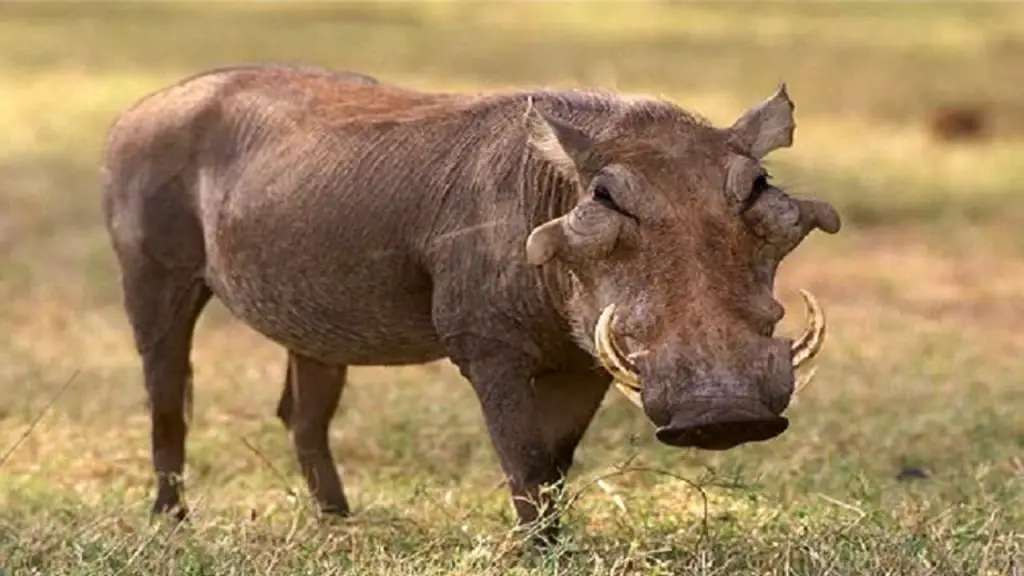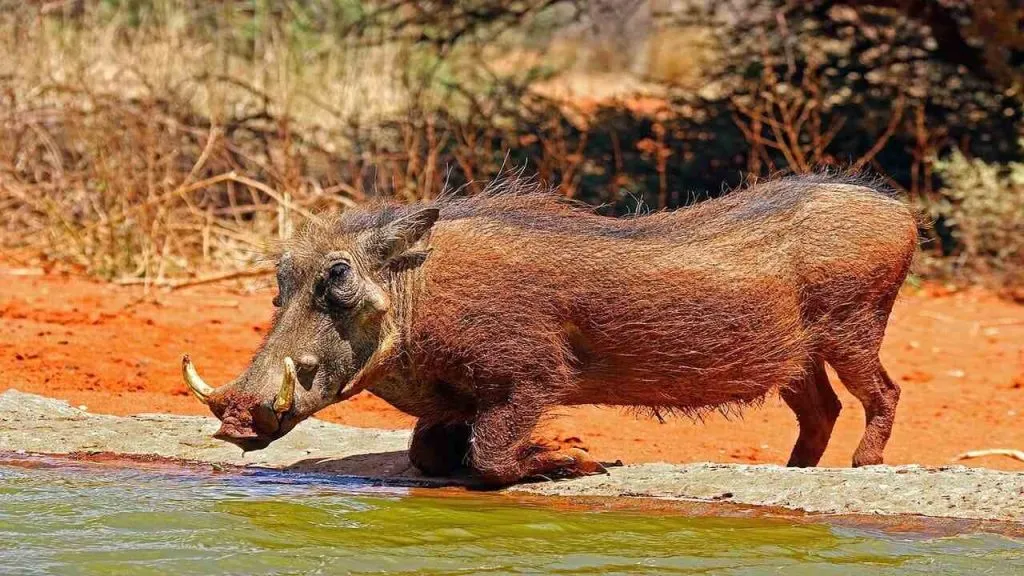As an Amazon Associate I earn from qualifying purchases.
Warthogs are interesting mammals found in Africa and the Middle East.
They’re quite social, living in groups known as sounders, typically comprising two to twenty members led by a dominant male and several females.
As part of the Suidae family, which includes pigs, boars, and hogs, warthogs share a social structure with their relatives. Now, what do warthogs eat?
These animals, with their unique appearance, inhabit various regions across Africa.
Beyond their looks, understanding their eating habits, where they prefer to live, and their conservation status gives us valuable insights into their role in the environment.
This article explores different aspects of warthog life, covering their diet, habitat, hunting methods, and the challenges they encounter in terms of conservation.
But before we dive into their eating preferences, let’s first explore the various types of warthogs.
Different Types of Warthogs

Warthogs, come in various species, each with unique traits and food preferences.
1. Common Warthog:
The Common Warthog, which is scientifically called Phacochoerus africanus, is easily recognizable by its facial warts, long tusks, and a special mane of hair on its back.
These animals live in many different places in sub-Saharan Africa, like grasslands, savannas, and woodlands.
Common Warthogs eat a mix of things – grass, roots, fruits, and sometimes even insects or small animals.
They can change what they eat depending on the time of year because they’re adaptable.
2. Desert Warthogs:
Desert Warthogs, also called Phacochoerus aethiopicus, are specially built for dry places.
They’re smaller than Common Warthogs and live in arid regions like deserts in eastern and southern Africa.
These little, furry warthogs are smart eaters, digging for tasty roots and bulbs.
They explore rocky areas for hidden treats and rely on fruits like those from doum palms for moisture and nutrients during dry times.
They’re good at adapting and can even scavenge for carrion or eat termite mounds, showing how well they survive in tough, dry conditions.
Both kinds of warthogs are interesting animals that play crucial roles in their environments.
Because they can eat many different things and are clever at finding food, they can do well in different parts of Africa.
What do Warthogs Eat in the Wild?
1. Spring
When the dry season turns into rainy spring, warthogs leave their homes excited to find lots of food.
The ground is covered in fresh, green grass, and the warthogs use their strong snouts to grab the tasty stems.
They especially like eating the young shoots and leaves of new plants, making them feel refreshed and giving them energy after the dry months.
2. Summer
During the summer, when the sun is shining, warthogs start eating roots and bulbs.
As the season continues, they still eat grass and plants to stay healthy.
Because it can get dry and hot, they find places with water to drink and stay hydrated. They also look for fruits like fallen berries.
Warthogs use their strong snouts and hooves to dig efficiently and find yummy tubers and rhizomes, which are like hidden treasures for them.
3. Autumn
With the rain decreasing and leaves changing, warthogs focus on fruits and berries. The sweet and juicy taste provides a pleasant break from their usual food.
They forage for fallen fruits from trees like baobabs and marulas, enjoying the burst of flavor and extra vitamins.
As the temperatures rise, drier conditions become more common, prompting warthogs to concentrate on areas near water sources to stay hydrated.
4. Winter
During winter in the savanna, finding food is tricky for warthogs. But these smart animals don’t give up.
They get a bit more into eating meat, like insects, grubs, and sometimes eggs or carrion.
Their strong snouts and jaws are super useful for munching on these protein-packed snacks.
Even though they don’t need as much water in winter, they still search for water to stay hydrated.
Now, let’s find out what the baby warthogs like to eat and drink.
What do Baby Warthogs Eat and Drink?
Baby warthogs, also called piglets, go through some changes in what they eat as they grow.
At first, they rely on their mom’s milk, which gives them important nutrients.
As they get older, around four months, they start trying out new things. They nibble on soft grass with their moms, learning how to snack in the savanna.
As they grow up, their noses become strong tools for digging, and they join their family in finding roots and bulbs, especially during the dry season when there’s not much greenery.
When tasty berries and fruits appear, the little ones enjoy the special treat with extra vitamins and sugars.
Like their grown-up relatives, baby warthogs sometimes eat crunchy snacks, like grubs or insects.
These lively piglets must drink enough water, and they learn from their moms how to find waterholes and puddles.
Sometimes, they even take a sip from other animals, and their playful splashing is fun to watch!
Habitat of Warthogs

Warthogs, which are very good at adapting, live in different places across Africa.
You can find them in grassy areas, open plains, woodlands, and semi-dry places.
They are smart and can thrive in various environments.
Warthogs make homes by digging burrows or dens using their strong digging skills.
These burrows help keep them safe from other animals that might want to harm them and protect them from extreme weather like very hot or very cold conditions.
Having the right kind of home is crucial for their survival.
Because warthogs live in so many different habitats, they play important roles in keeping the environment balanced.
Whether they are in open grassy areas or more sheltered woodlands, warthogs help maintain a healthy balance in nature.
Understanding where they like to live is vital for protecting and taking care of these interesting creatures.
The Hunting Method of Warthogs
Warthogs aren’t usually thought of as hunters; they’re more like animals that other creatures might hunt.
But even though they’re not aggressive, they have ways to stay safe from danger.
Warthogs have strong bodies and big tusks that they use to protect themselves.
When there’s a threat, they quickly go into their homes on the ground, using their tusks to block the entrance.
They survive not by actively hunting for food, but by being good at avoiding trouble and defending themselves.
Warthogs are quick and can run up to 30 miles per hour to escape from things that might harm them.
They also have sharp hearing and eyesight to notice danger around them.
In short, warthogs aren’t hunters; instead, they have strong bodies and smart behaviors to avoid and protect themselves from other animals that might want to harm them.
The way they hide in their homes and use their tusks shows how they stay safe in the wild.
Which Animals Consume Warthogs?
Many animals in the wild see warthogs as food. Some of the main ones are:
- Lions: Lions are strong hunters and like to eat warthogs, especially the young or weaker ones.
- Leopards: Leopards are good at climbing and may surprise warthogs from trees or attack them on the ground.
- Hyenas: Hyenas are clever scavengers and hunters. They might go after warthogs when they get the chance.
- Cheetahs: Although it’s rare, cheetahs might also go for warthogs, especially if they’re young or not as strong.
- Crocodiles: In places where warthogs go to drink or cross rivers, crocodiles can be a threat to them.
- African Wild Dogs: These dogs, also called painted dogs, hunt in groups and might go after warthogs together.
These predators help keep the balance in nature by hunting herbivores like warthogs.
Warthogs try to stay safe by hiding in burrows and using their tusks, but they can’t always avoid every danger.
The Conservation Status
Warthogs, those funny-looking animals with snouts and big smiles, might seem carefree, but their situation is more complicated than it looks.
Although they’re not currently in danger according to experts, there are things we need to pay attention to.
The good news is that common warthogs, especially in Southern Africa, have a population of over 250,000 and are doing well in many protected areas.
They’re tough because they can eat different things and have lots of babies.
However, there are still problems like losing their homes because people use more land for farming, and sometimes they’re hunted for meat and tusks.
Also, there’s a sickness called African swine fever that can affect them, and changes in the weather can make it harder for them to find food and water.
To ensure these interesting animals keep thriving, we must protect their homes, involve local communities, prevent diseases, and do our part to deal with climate change.
Conclusion
Warthogs, with their unique looks and fascinating actions, are important in the places they live.
To help them thrive, it’s essential to know what they like to eat, where they like to live, and the problems they deal with.
If we understand these things about warthogs, we can devise good plans to keep them safe and ensure they stay a part of their homes.
Appreciating the details of how warthogs live helps us protect these amazing animals and the places they belong.
FAQ’s:
Yes, warthogs can eat grass. It’s a common part of their diet.
Warthogs enjoy a variety of foods, but they particularly like roots, tubers, and fruits.
They are not very picky eaters.
Warthogs are mainly herbivores, meaning they primarily eat plants.
While they might scavenge on occasion, they are not known to be regular consumers of dead animals.
Yes, warthogs do eat fruit. Fruits, along with other vegetation, contribute to their diet.
Amazon and the Amazon logo are trademarks of Amazon.com, Inc, or its affiliates.

